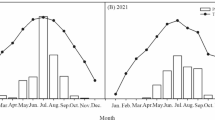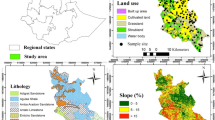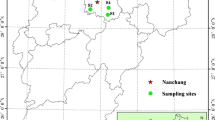Abstract
Purpose
The aim of this study was to investigate the resistance of aggregates to flooding stresses for different soil types and present implications for the restoration of eroded soils.
Materials and methods
Twelve field sites for three soil types were selected and separated into four hydrological stress levels at the riparian zones of the Three Gorges Reservoir. Soil samples were collected randomly, followed by lab analysis of soil mechanical composition, soil aggregate and stability, and soil carbon and nitrogen contents in the bulk soil and different sizes of aggregates.
Results and discussion
Clay and silt migrated from the upper water level sites to lower water level sites for Regosols under hydrological stresses; however, the mechanical compositions were not changed for Anthrosols and Luvisols. Total carbon content (TC), total nitrogen content (TN), and carbon and nitrogen ratio (C/N) were highest under strong hydrological stress for all-sized aggregates and bulk soils. Aggregate disintegration under hydrological stresses made organic matter exposed, but the anaerobic environment created by flood avoided organic matter from being decomposed. Most TC and TN in aggregates and bulk soils were negatively correlated with stability. Compared with Anthrosols and Luvisols, Regosols had lower aggregate stability due to its low large macro-aggregate proportions for each stress level. Therefore, much attention should be given to Regosols which has a high potential for erosion. Resistances of aggregates to strong and intermediate hydrological stress were higher for Anthrosols than other tested soils. However, Luvisols had the highest resistance to hydrological stresses because of its higher stability above the elevation of 165 m, due to its highest small macro-aggregate proportion. Therefore, anthropogenic restorations are recommended to stabilize the structure of Anthrosols and Luvisols under weak and strong hydrological stress, respectively.
Conclusions
The operation of the Three Gorges Reservoir forced the riparian ecosystem to undergo periodical flooding stresses. The resistance of soil aggregates to hydrological stresses was lowest for Regosols, which should be concerned urgently to reduce soil losses. Under strong and intermediate hydrological stresses, Anthrosols had greater stability to maintain its original structure. However, the aggregate stability of Luvisols was higher for weak and none hydrological stress levels. Hence, anthropogenic restorations are recommended to take priorities for Anthrosols and Luvisols to reduce soil erosion under weak and strong hydrological stress, respectively.




Similar content being viewed by others
References
An S-S, Darboux F, Cheng M (2013) Revegetation as an efficient means of increasing soil aggregate stability on the Loess Plateau (China). Geoderma 209-210:75–85
Arthur E, Schjønning P, Moldrup P, de Jonge LW (2012) Soil resistance and resilience to mechanical stresses for three differently managed sandy loam soils. Geoderma 173-174:50–60
Bakhshandeh S, Norouzi M, Heidari S, Bakhshandeh S (2014) The role of parent material on soil properties in sloping areas under tea plantation in Lahijan, Iran. Carpathian Journal of Earth and Environmental Sciences 9:159–170
Banach AM, Banach K, Visser EJW, Stępniewska Z, Smits AJM, Roelofs JGM, Lamers LPM (2009) Effects of summer flooding on floodplain biogeochemistry in Poland; implications for increased flooding frequency. Biogeochemistry 92:247–262
Barral MT, Buján E, Devesa R, Iglesias ML, Velasco-Molina M (2007) Comparison of the structural stability of pasture and cultivated soils. Sci Total Environ 378:174–178
Bronick CJ, Lal R (2005) Soil structure and management: a review. Geoderma 124:3–22
Cameron FK (1905) A comparsion of the organic matter in different soil types. J Am Chem Soc 27:256–258
Campbell DA, Cole CA, Brooks RP (2002) A comparison of created and natural wetlands in Pennsylvania, USA Wetlands. For Ecol Manag 10:41–49
Castro Filho C, Lourenço A, Guimarães M de F, ICB F (2002) Aggregate stability under different soil management systems in a red latosol in the state of Parana, Brazil. Soil Till Res 65:45–51
Chang C, Xie Z, Xiong G, Chu L (2011) The influences of Three Gorges reservoir to soil properties of hydro-fluctuation areas. J Natural Resour 26:1236–1244
Cheng M, Xiang Y, Xue Z, An S, Darboux F (2015) Soil aggregation and intra-aggregate carbon fractions in relation to vegetation succession on the Loess Plateau, China. CATENA 124:77–84
Cheng R, Liu Z, Xiao W, Wang X, Shen Y (2017) The variation of soil physical properties in typical hydro-fluctuation area of Three Gorges reservoir. For Sci 53:19–25
Ciric V, Manojlovic M, Nesic L, Belic M (2012) Soil dry aggregate size distribution: effects of soil type and land use. J Soil Sci Plant Nutr 12:689–703
Cui J, Tang X, Zhang W, Liu C (2018) The effects of timing of inundation on soil physical quality in the water-level fluctuation zone of the Three Gorges Reservoir Region, China. Vadose Zone J:17. https://doi.org/10.2136/vzj2018.03.0043
Davidson EA, Janssens IA (2006) Temperature sensitivity of soil carbon decomposition and feedbacks to climate change. Nature 440:165–173
De La Cruz AA (1986) Tropical wetlands as a carbon source. Aquat Bot 25:109–115
Fang H et al (2019) Temporal dynamics of paddy soil structure as affected by different fertilization strategies investigated with soil shrinkage curve Soil and Tillage Research 187:102-109
Hagedorn F, Maurer S, Egli P, Blaser P, Bucher JB, Siegwolf R (2001) Carbon sequestration in forest soils: effects of soil type, atmospheric CO2 enrichment, and N deposition. Eur J Soil Sci 52:619–628
Haydu-Houdeshell C-A, Graham RC, Hendrix PF, Peterson AC (2018) Soil aggregate stability under chaparral species in southern California. Geoderma 310:201–208
Hefting M, Clément JC, Dowrick D, Cosandey AC, Bernal S, Cimpian C, Tatur A, Burt TP, Pinay G (2004) Water table elevation controls on soil nitrogen cycling in riparian wetlands along a European climatic gradient. Biogeochemistry 67:113–134
Heikkinen J, Keskinen R, Soinne H, Hyväluoma J, Nikama J, Wikberg H, Källi A, Siipola V, Melkior T, Dupont C, Campargue M, Larsson SH, Hannula M, Rasa K (2019) Possibilities to improve soil aggregate stability using biochars derived from various biomasses through slow pyrolysis, hydrothermal carbonization, or torrefaction. Geoderma 344:40–49
Huo L, Zou Y, Lyu X, Zhang Z, Wang X, An Y (2018) Effect of wetland reclamation on soil organic carbon stability in peat mire soil around Xingkai Lake in Northeast China. Chinese Geograph Sci 28:325–336
Iqbal J, Hu R, Feng M, Lin S, Malghani S, Ali IM (2010) Microbial biomass, and dissolved organic carbon and nitrogen strongly affect soil respiration in different land uses: a case study at Three Gorges Reservoir Area, South China. Agric Ecosyst Environ 137:294–307
Kemper WD, Rosenau RC (1986) Aggregate stability and size distribution. In: Klute A (ed) Methods of soil analysis, 2nd edn. Part 1. Agronomy monograph 9, Madison, Wisconsin, pp 425–442
Le Bissonnais Y (1996) Aggregate stability and assessment of soil crustability and erodibility: I. theory and methodology. Eur J Soil Sci 47:425–437
Li F, Zhang W, Liu J, Xia J, Wang J (2013) Soil microbial activities in the water-level -fluctuating zone of Three Gorges Reservoir area during discharging period. Chinese J Ecol 32:968–974
Mikha MM, Rice CW (2004) Tillage and manure effects on soil and aggregate-associated carbon and nitrogen contribution no. 03-86-J of Kansas Agric. Exp. Stn Soil Sci Soc Am J 68:809–816
Neidhardt H, Norra S, Tang X, Guo H, Stüben D (2012) Impact of irrigation with high arsenic burdened groundwater on the soil–plant system: results from a case study in the Inner Mongolia, China. Environ Pollut 163:8–13
Neill C (1995) Seasonal flooding, nitrogen mineralization and nitrogen utilization in a prairie marsh. Biogeochemistry 30:171–189
New T, Xie Z (2008) Impacts of large dams on riparian vegetation: applying global experience to the case of China’s Three Gorges Dam. Biodivers Conserv 17:3149–3163
Nichols KA, Toro M (2011) A whole soil stability index (WSSI) for evaluating soil aggregation. Soil Till Research 111:99–104
Nie X, Li Z, Huang J, Liu L, Xiao H, Liu C, Zeng G (2018) Thermal stability of organic carbon in soil aggregates as affected by soil erosion and deposition. Soil Till Res 175:82–90
Nilsson C, Berggren K (2000) Alterations of riparian ecosystems caused by river regulation: dam operations have caused global-scale ecological changes in riparian ecosystems. AIBS Bull 50:783–792
Oades JM (1984) Soil organic matter and structural stability: mechanisms and implications for management. Plant Soil 76:319–337
Obalum SE, Uteau-Puschmann D, Peth S (2019) Reduced tillage and compost effects on soil aggregate stability of a silt-loam Luvisol using different aggregate stability tests. Soil Till Res 189:217–228
Saint-Laurent D, Gervais-Beaulac V, Berthelot J-S (2014) Variability of soil properties in different flood-risk zones and link with hydroclimatic changes (Southern Québec, Canada). Geoderma 214-215:80–90
Sakin E (2012) Organic carbon organic matter and bulk density relationships in arid-semi arid soils in Southeast Anatolia region. Afr J Biotechnol 11:1373–1377
Schoonover JE, Crim JF (2015) An introduction to soil concepts and the role of soils in watershed management. J Contemp Water Res Educat 154:21–47
Simpson RT, Frey SD, Six J, Thiet RK (2004) Preferential accumulation of microbial carbon in aggregate structures of no-tillage soils. Soil Sci Soc Am J 68:1249–1255
Six J, Elliott ET, Paustian K (2000) Soil macroaggregate turnover and microaggregate formation: a mechanism for C sequestration under no-tillage agriculture. Soil Biol Biochem 32:2099–2103
Six J, Bossuyt H, Degryze S, Denet K (2004) A history of research on the link between (micro)aggregates, soil biota, and soil organic matter dynamics. Soil Till Res 79:7–31
Steiger J, Tabacchi E, Dufour S, Corenblit D, Peiry J-L (2005) Hydrogeomorphic processes affecting riparian habitat within alluvial channel–floodplain river systems: a review for the temperate zone. River Res Appl 21:719–737
Tisdall JM, Oades JM (1982) Organic matter and water-stable aggregates in soils. J Soil Sci 33:141–163
Torri D, Ciampalini R, Gil PA (1998) The role of soil aggregates in soil erosion processes. In: Modelling soil erosion by water. Springer, Berlin, Heidelberg, pp 247–257
Wang Y, Chen F, Zhang M, Chen S, Tan X, Liu M, Hu Z (2018) The effects of the reverse seasonal flooding on soil texture within the hydro-fluctuation belt in the Three Gorges reservoir, China. J Soils Sediments 18:109–115
Wei Y, Wu X, Cai C (2015) Splash erosion of clay–sand mixtures and its relationship with soil physical properties: the effects of particle size distribution on soil structure. CATENA 135:254–262
Wolf KL, Ahn C, Noe GB (2011) Development of soil properties and nitrogen cycling in created wetlands. Wetlands 31:699–712
Ye X, Bai J, Lu Q, Zhao Q, Wang J (2014) Spatial and seasonal distributions of soil phosphorus in a typical seasonal flooding wetland of the Yellow River Delta, China. Environ Earth Sci 71:4811–4820
Yoder RE (1936) A direct method of aggregate analysis of soils and a study of the physical nature of erosion losses. J Am Soc Agron 28:337–351
Zhang B, Horn R (2001) Mechanisms of aggregate stabilization in Ultisols from subtropical China. Geoderma 99:123–145
Zhang J, Li S, Dong R, Jiang C, Ni M (2019) Influences of land use metrics at multi-spatial scales on seasonal water quality: a case study of river systems in the Three Gorges Reservoir Area, China. J Clean Prod 206:76–85
Zhao J, He X, Shao T (2012) Material composition and microstructure of purple soil and purple mudstone in Chongqing area. Acta Pedol Sin 49:212–219
Zheng Z, Parent LE, MacLeod JA (2003) Influence of soil texture on fertilizer and soil phosphorus transformations in Gleysolic soils. Can J Soil Sci 83:395–403
Zhong ZC, Qi DH (2008) The illustrated species catalog and biodiversity in the hydro-fluctuation belt of Three Gorges Reservoir. D, Southwest China Normal University Press
Zhou H, Peng X, Peth S, Xiao TQ (2012) Effects of vegetation restoration on soil aggregate microstructure quantified with synchrotron-based micro-computed tomography. Soil Till Res 124:17–23
Zhu X (1989) Soil and agriculture in loess plateau. Agricultural Press, Beijing (in Chinese)
Acknowledgments
We are grateful to Yuyao Zhang and Jiacheng Wang for their experimental assistance.
Funding
This study was financially supported by the National Natural Science Foundation of China (41771266 and 41401243), Research Fund of State Key Laboratory of Soil and Sustainable Agriculture, Nanjing Institute of Soil Science, Chinese Academy of Science (No. Y812000005), and the Youth Innovation Promotion Association of the Chinese Academy of Sciences (No. 2017391).
Author information
Authors and Affiliations
Corresponding author
Additional information
Responsible editor: Lu Zhang
Publisher’s note
Springer Nature remains neutral with regard to jurisdictional claims in published maps and institutional affiliations.
Appendix
Appendix
GPS information on sampling sites for different soil types.
Rights and permissions
About this article
Cite this article
Ran, Y., Wu, S., Zhu, K. et al. Soil types differentiated their responses of aggregate stability to hydrological stresses at the riparian zones of the Three Gorges Reservoir. J Soils Sediments 20, 951–962 (2020). https://doi.org/10.1007/s11368-019-02410-7
Received:
Accepted:
Published:
Issue Date:
DOI: https://doi.org/10.1007/s11368-019-02410-7




